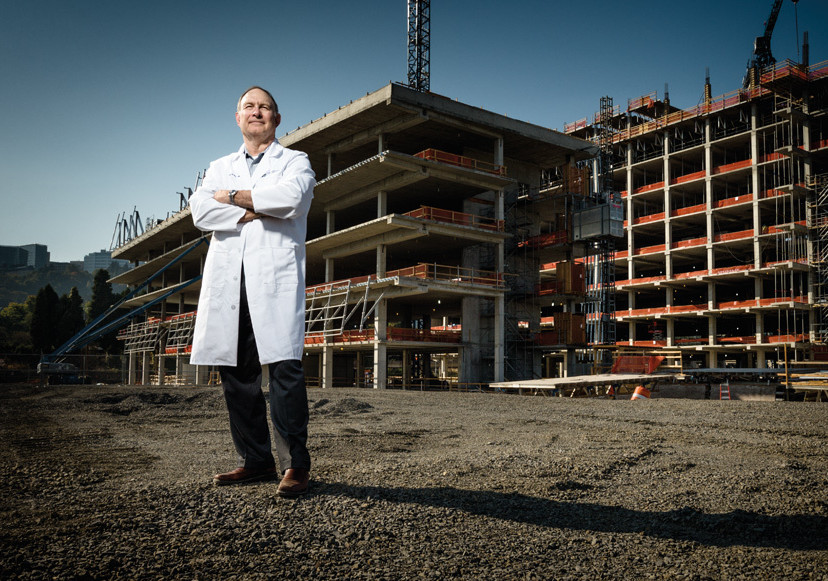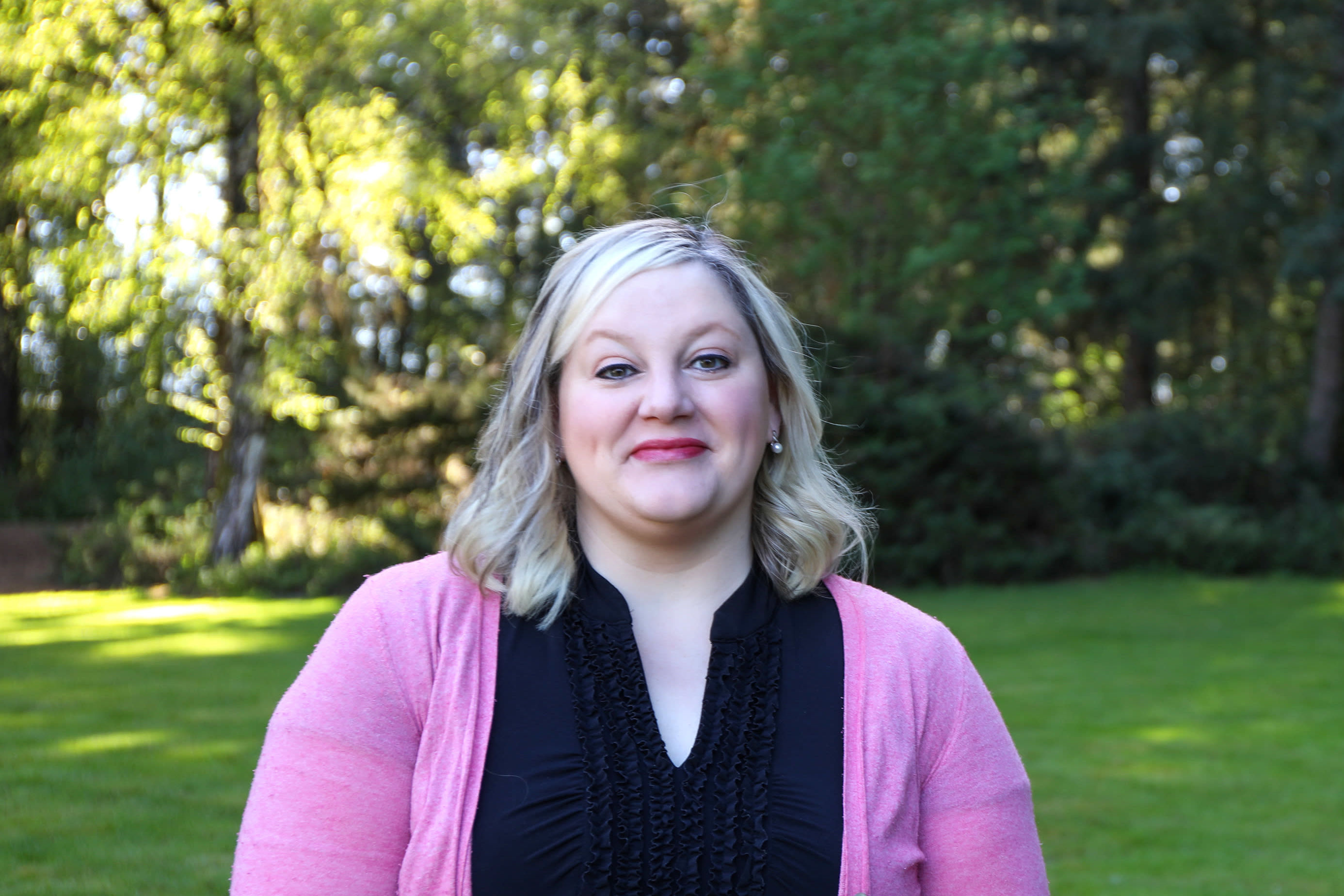OHSU's War on Cancer

OHSU’s Brian Druker stands in front of the under-construction Collaborative Life Sciences Building, which will house a key lab for the cancer-fighting program he leads.
Image: Andy Batt
VIDEO
A short history of the past and future of Oregon Health and Sciences University
When scientist Joe Gray reports to a new lab now under construction just north of the Ross Island Bridge, he’ll find himself on some of the firmest ground in the Northwest. His research suite is being designed and engineered to protect some of the world’s most powerful (and expensive) electron microscopes: devices that can create images of individual atoms, and can’t be allowed to vibrate any more than the thickness of a fingerprint on a piece of paper.
The lab’s location, in some ways, couldn’t be worse. Built atop jelly-like riverside soil, it will sit next to a rumbling streetcar and a new MAX line. And so engineers will surround those microscopes with a 30-foot-deep trench, isolating them from the rest of the foundation of the new Collaborative Life Sciences Building, a $295 million, 500,000-square-foot behemoth that will become home in spring 2014 to various programs run by Portland State, Oregon State, and Oregon Health & Science University. The lab will also sit on piles driven 130 feet into the ground to reach denser soils, plus a four-foot-thick concrete slab.

Image: Courtesy OHSU archive
Gray, a New Mexico native recruited to Portland in 2011, and his lab are part of an extraordinary effort at OHSU. Fitting metaphors for what man and machines will add to both the medical institution and Portland might include the Trail Blazers suddenly adding a Hall of Fame forward, or the Oregon Symphony nabbing enough philanthropy to build Portland’s own version of LA’s Disney Concert Hall. Gray, his lab, and the team of elite researchers who will work there are part of an audacious quest to change how we battle cancer, and to become one of the world’s leaders in that struggle.
The vision: a day when doctors can replace the assault of chemo and radiation with strikes that target specific tumors in individual patients—and even the genes and molecular structures within tumors. The man guiding this vision, Brian Druker, is already famous for developing Gleevec, one of the first drugs to target the genetic changes behind a specific cancer. Four years ago, Phil Knight, the Portland-born founder of Nike, and his wife, Penny, gave OHSU $100 million for cancer research—at the time, the largest gift in the school’s 125-year history. (The Knights later topped it with $125 million for heart research.)
The gift launched OHSU and Druker on a campaign of recruiting coups, scooping up top-tier researchers from elsewhere for the newly renamed Knight Cancer Institute. “We can attract the best ‘athletes’ at the peak of their careers to work here,” Druker says. “This attracts more talent, including the young stars of tomorrow, to move here to learn from the best and make their own contributions.”
Druker’s first two major scores are Gray, a pioneer in cancer imaging and genetics, and Lisa Coussens, a biologist who studies the environments in which tumors grow. While OHSU doesn’t disclose exact details, each such recruitment costs about $20 million in salaries, relocation money, and promised budget for researchers who will work with Gray and Coussens. Each brings a handpicked team of other top scientists with them, essentially moving whole labs (and millions in research budgets) to Portland from former employers Lawrence Berkeley National Laboratory and the University of California, respectively.
“Cancer is complex,” Druker says. “It’s not going to be one person or even one individual lab that solves the problem.”
The near-term goal will be creating a complete guide to cancer: a picture of how cells start growing out of control, how it lives, and how it spreads. As Druker explains it, “We’ll have a manual of every single part that can break.” Druker also wants to know more about what surrounds tumors, and how cancers interact with other cells. “We’re already figuring out how the broken parts are assembled into a cell and how to visualize them,” he says.
This understanding will help scientists develop more drugs that attack cancer on the most minute level, targeting the molecules in individual cancer cells. The ultimate payoff: an era in which life-saving results come without the punishing side effects of chemotherapy and radiation, which exact a toll on healthy cells even as they kill tumors. In the longer term, Druker wants to make Oregon’s death rate from cancer the lowest in the country. We currently rank smack dab in the middle, with 173.4 annual cancer deaths per 100,000 people. (Utah’s cancer mortality rate, 120.7, is the current lowest.)
These goals could take decades to achieve. But the team that will pursue it is coming together now—led by scientists whose insights and drive represent Portland’s best chance to rewrite a feared ailment’s future.
Brian Druker
Fast-tracking science
Today, Brian Druker manages an annual budget of about $120 million. In the early ’90s at Harvard, he could barely get his research funded.
Druker wanted to study drugs that could target the molecules causing abnormal cell growth in a white-blood-cell cancer called chronic myeloid leukemia (CML). He was developing a drug that interfered with biochemical processes inside cancerous cells themselves that were driving their growth—a complete contrast with an earlier, less-direct approach of blocking activity on the surface of cancer cells. (“It’s getting into the criminal’s head and changing the criminal’s behavior, ” says Otis Brawley, chief medical officer at the American Cancer Society, “versus handcuffing the criminal and throwing it into jail.”) Many in the field considered this idea too new and untested to fund with precious grant money. Druker managed to win OHSU’s backing in 1993—a gamble that led to his pioneering drug Gleevec and simultaneously made and saved Druker’s career. “Quite honestly, if it had failed,” Brawley says, “Brian would have been drummed out of academics.”
Gleevec transformed the prospects of people afflicted with CML—where once patients almost always died within five or six years, most can now manage the cancer as a chronic illness. It also broke open the field of targeted cancer therapy, an approach that seeks to treat cancers not just based on what part of the body they attack—as breast cancer, colon cancer, and so on—but by the makeup of the tumors themselves. Today there are as many as 40 such drugs on the market, Druker estimates, with hundreds more in clinical trials. In 2009, Druker won a share of the coveted Lasker-DeBakey Clinical Medical Research award—considered America’s Nobel. (He’s been mentioned as a potential recipient of the actual Nobel.)
But the broader potential, as he sees it, lies in expanding Gleevec’s basic concept—attacking a specific cancer using a nuanced understanding of how it works—to battle all cancers, perhaps even before they start. “We may get to a point where we understand the molecular basis of risks,” Druker says, “and could use a treatment that would prevent people from developing cancer.”
As the Knight Cancer Institute’s leader, the soft-spoken Minnesota native sees his role as building a team that can turn that theoretical insight into clinical practice—fast. “Whether it’s with one drug, five drugs, or 10 drugs,” Druker says, “I just want to make an impact, and I want to do it as quickly as we can.”

The microscopes in Joe Gray’s new lab in the Collaborative Life Sciences Building will be capable of seeing an individual gene or atom.
Image: Andy Batt
Joe Gray
Seeing molecules and mechanisms
Joe Gray has a very personal motivation for advancing cancer research. When he was 24, he lost his father to lung cancer. Later his wife developed breast cancer, and both he and his son have had skin cancer. “I’ve dealt with the disease firsthand,” he says. “I’ve seen the limitations of current treatments. That gap in our knowledge has a profound effect on people’s lives.”
Today, Gray is creating what he calls the “Google Earth” view of cancer cells and tissues: a way of zooming in and out on the disease in the body. “We want to be able to see, at a higher level, how the tissues are organized,” the biomechanical engineer explains, “and at a lower level how the cells are organized, and at a lower level still, how molecular complexes that make up cells are organized—and how all of this works together.” To that end, his new lab will house as many as six high-powered electron microscopes built by Hillsboro’s FEI, the industry leader. One, the Titan Krios, sells for as much as $6 million depending on how it’s configured; in 2010, scientists at UCLA used the same model to capture images of individual atoms in a frozen virus, a feat previously considered impossible. FEI is both footing part of the bill for the necessary instruments and planning to embed its own scientists in Gray’s lab. The instruments include electron microscopes so powerful, they allow researchers to see individual genes on cancer cells, as well as a groundbreaking model that lets scientists switch between big-picture views—a bunch of cancer cells, for example—and even more infinitesimally small features, like chromosomes within one of those cells.
As a pioneer in the imaging of very small things—he developed microscope techniques now widely used to detect breast cancer mutations—Gray aims to usher in a new understanding of cancer’s basic workings. “We need to understand how cancer cells function, how they grow, how they die, how they move, how they make new blood vessels,” he says. To do this, Gray and his colleagues will observe cancerous cells in various locations throughout the body in a way that no one has been able to do before.
“It’s the difference between seeing the parts and seeing the parts all working together,” Druker says.
Just as astronomers stitch together composite views of the sky with different types of telescopes, Gray says his microscopes will together make possible a picture of how genomic abnormalities drive different cancers in individual patients. “I think it’s going to be very clear that cancer differs from person to person,” he says, “and that’s going to have a fundamental impact on how the individual cancer patient will respond.”

Lisa Coussens brings a robust team of researchers with her in her move to OHSU.
Image: Andy Batt
Lisa Coussens
Rewiring rogue immune cells
“It took about one second,” says Lisa Coussens about convincing the researchers in her lab at the University of California–San Francisco to make the move with her to OHSU late last year. Three of them jumped at the chance to work with Druker, whose goal is to turn lab results into treatments for living, breathing human beings.
“Brian has assembled a team of people that think about that path and what’s needed,” she says, “and not only from an ‘interesting science’ point of view.” In addition to those specialists, her deal with OHSU also provides funding to hire 10 cancer biologists. Each of their labs will have 10 to 15 people working within them. “It’s a tremendous boon to the scientific community,” she says, “but also a tremendous boon to the Portland economy.”
Coussens has spent the past 20 years battling cancer’s most insidious move: hijacking the body’s immune system. Ordinarily, immune cells help to maintain tissue and organ health and ward off infections. “Clearly without them we’d be a mess,” Coussens says. Tumors, however, take advantage of immune cells’ protection to thwart normal cell death and boost their own abnormal growth. Researchers still don’t know exactly how all this works. But Coussens recently discovered that when she used targeted drugs to eliminate compromised immune cells in and around tumors in lab mice, the cancer cells became more vulnerable to chemo and radiation. What’s more, when she eliminated the co-opted immune cells, healthy immune cells stepped in and did their job, killing off malignant growths.
In hot pursuit of these insights, Coussens is now overseeing the first-ever human trial to combine chemotherapy with a drug that targets rogue immune cells.
Eventually, Coussens wants to reprogram these compromised immune cells to make them keep tumors in check rather than helping them to grow. Immune cells also appear to help tumors get oxygen and nutrients, in ways not yet understood. Thus, changing how such cells function could put cancer in a double bind. As Coussens puts it: “One rock, two birds.”





